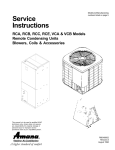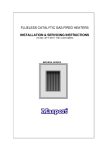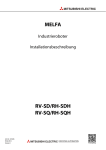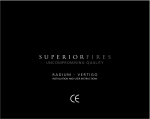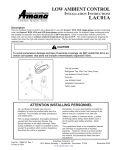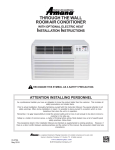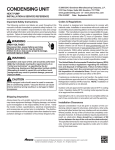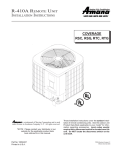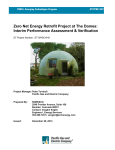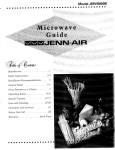Download CCF-CHF IO MANUAL
Transcript
CCF/CHF Cased Horizontal Evaporator Coil Installation Instructions R C October 2002 Rev. 4 (1) R Goodman Company, L.P. 1810 Wilson Parkway • Fayetteville, Tennessee 37334 www.amana-hac.com 10618412 Table of Contents General ...................................................................................................................................... 2 Shipping and Handling ................................................................................................................................... 2 Location Requirements .................................................................................................................................. 2 Product Application ........................................................................................................................................ 2 Installation Instructions ........................................................................................................... 3 PreInstallation Requirements ........................................................................................................................ 3 Installation ....................................................................................................................................................... 3 Furnace ............................................................................................................................................................................................... 3 Blower Section .................................................................................................................................................................................... 4 Refrigerant Piping .................................................................................................................... 5 Job Site Brazing .................................................................................................................................................... 5 Refrigerant Charge ................................................................................................................................................ 5 Restrictor Orifice ................................................................................................................................................... 5 Refrigerant Piping .................................................................................................................... 6 TXV Kit Installation (CCF Only) ........................................................................................................................... 6 Refrigerant Pipe Connections .............................................................................................................................. 6 Drain Connection ..................................................................................................................... 7 Maintenance.............................................................................................................................. 7 Condensate System Maintenance (Qualified Servicer Only) ............................................................................. 7 Air Filters ............................................................................................................................................................... 7 Filter Maintenance ................................................................................................................................................. 7 Coil Cleaning ......................................................................................................................................................... 7 • Units must be installed in accordance with Regulations of the National Fire Protection Association and applicable local codes. Where local regulations are at a variance with instructions, installer should adhere to local codes. • Before connecting tubing, read the outdoor unit installation manual. Pay particular attention to all safety precautions. RECOGNIZE THIS SYMBOL AS A SAFETY PRECAUTION. ATTENTION INSTALLING PERSONNEL As a professional installer you have an obligation to know the product better than the customer. This includes all safety precautions and related items. Remember, it is your responsibility to install the product safely and to know it well enough to be able to instruct a customer in its safe use. Prior to actual installation, thoroughly familiarize yourself with this Instruction Manual. Pay special attention to all safety warnings. Often during installation or repair it is possible to place yourself in a position which is more hazardous than when the unit is in operation. Safety is a matter of common sense...a matter of thinking before acting. Most dealers have a list of specific good safety practices...follow them. The precautions listed in this Installation Manual are intended as supplemental to existing practices. However, if there is a direct conflict between existing practices and the content of this manual, the precautions listed here take precedence. 2 General Product Application These horizontal coils can be installed on a furnace or air handling unit. They are specifically designed to “match up” with Amana condensing units and heat pumps to provide high efficiency heating or cooling. These coils are suitable for either attic or crawl space installations. Its bi-directional airflow provides greater flexibility in horizontal left and horizontal right applications. Non-bleed thermal expansion valve kits can be field installed on CCF coils (See “Specification Sheet”). Thermal Expansion Valves (TXV) and flow restrictors give accurate refrigerant control and provide reliable operation over a wide range of conditions. To avoid poor operation or equipment damage, any single-phase reciprocating compressor used with an expansion valve coil must include hard start components. Ensure that the outdoor unit has hard start components or install a hard-start kit. See the outdoor unit “Specification Sheet” for the proper kit number. NOTE: It may be necessary to change the factory-installed expansion valve on a CHF**TCC coil in order to match the outdoor unit capacity. CHF**TCC Required TXV Kit Outdoor Capacity Coil Size CHF18TCC TXV01A 1 1/2 to 2 tons CHF24TCC CHF30TCC CHF36TCC CHF42TCC CHF48TCC CHF60TCC TXV02A 2 1/2 to 3 tons TXV03A 3 1/2 to 5 tons For service operating conditions, refer to the “Specification Sheet” from the matching condensing unit. • Only allow qualified, experienced technicians to install or service this unit. Shipping and Handling All units are securely packed in shipping containers tested according to International Safe Transit Association specifications. Upon receipt of the coil assembly, inspect for any damage which may have occurred in transit. If damage is obvious, it should be noted on the carrier’s freight bill for inspection and initiation for settlement of claim be made at once. Units are usually shipped F.O.B. factory, and it is the consignee’s responsibility to file damage claims. If no damage is found, shipping material should be removed and properly discarded. Location Requirements The coil can be installed with zero clearance to combustible materials. Adequate room must be provided for servicing, routing of refrigerant lines, and routing of drain lines including a drain trap. Do not locate the unit directly on the ground or in an area that may become wet. If installed over a finished ceiling or living space, a secondary drain pan (with drain line) should be positioned under the entire unit. 3 Installation Instructions PreInstallation Requirements Rods COIL SIZING Coils should be sized prior to installation based on recommended matches to the outdoor unit. Refer to sales literature and the ARI directory. Install unit in accordance with Regulations of the National Fire Protection Association and applicable local codes. Where there are variances with the national code, adhere to local codes. Air Flow Furnace The capacity of the cooling or heating system is obtained from the published ratings. Support Isolation Pads Figure 1 NOTES: • For TXV installation, select the TXV kit specified on the condensing unit specification sheet or sales literature. • For orifice installation, select the orifice size specified by the outdoor unit. Coil Section Blower Section Air Flow COIL CLEANING To obtain optimum performance on initial start-up, the coil assembly must be cleaned with a mild dishwashing detergent or coil cleaner to remove any manufacturing oil residue, dirt, or other foreign substances from the coil finned surfaces. Figure 2 COIL ATTACHMENT Installation Furnace When attaching the coil to either a gas or oil furnace, mount the coil at the supply air end of the furnace (unless the furnace manufacturer instructs otherwise). Ensure the drain pan is down. For proper drainage, the coil must be level or pitched toward the drain connections. If necessary, shim under the furnace so the furnace and coil casing will both be level or pitched toward the drain. The Cased Horizontal Evaporator Coil can be installed either suspended (Figure 1) or directly on a surface (Figure 2). In either installation, ensure the coil bottom is fully supported and resting on rubber isolation pads. These pads will minimize vibration and sound transmission to the structure. CAUTION Horizontal Left Applications In this application, the opening in the right side of the casing mates with the supply side flanges on Amana Air Command™ furnaces. Ensure the furnace flanges are turned up. It is the installer’s responsibility to ensure the coil is properly supported. Horizontal Right Applications In this application, if you wish to create more surface area for attachment of duct work (Figure 3), turn the front panel 180°. 4 Installation Instructions 3. Lift up the pan mount and slide the bottom duct flange underneath onto the casing flange (Figure 3). Coil Casing Coil Casing Wide Side Flip 180º Thin Side Pan Mount Front Panel Figure 3 Duct Flange If the furnace and coil are not similar in depth and width, a transition will have to be field-supplied. Center the furnace and coil openings relative to each other. Fasten the assembly securely, and seal as necessary to reduce air leakage. Do not allow screws to penetrate the coil drain pan or tubing. Figure 3 4. Lower pan mount. Secure duct flange and pan mount to the coil casing using the screws removed in step 2. Duct Flange Attachment The duct flanges for the return air side are shipped unattached. If necessary, carefully drive the flanges into place using a mallet. In an horizontal left application use three (3) flanges; in an horizontal right application use four (4). Blower Section The cased coil is designed to mate flush with a BBA/BBC blower section on either horizontal right or horizontal left applications. 1. Slide the top and side duct flanges onto the casing flange. Note: Left side duct flange is not used in horizontal left installations. 2. Remove the screws attaching the pan mount to the coil casing. The coil section must be mounted “upstream” (return air side) of the blower section. Use three adapter plates to connect the coil and blower section together, one on each side and one on the back. NOTE: Two adapter plates are shipped with the blower section and one with the coil section. Refer to Duct Flange Attachment section to complete installation. 5 Refrigerant Piping Job Site Brazing Restrictor Orifice See companion outdoor condensing unit instructions for recommendations on field piping of interconnecting refrigerant lines. REMOVAL Line sizes for runs of fifty feet or less should be based on the line diameters of the outdoor unit. For lengths greater than 50 feet, refer to the product service manual. A field provided adapter may be necessary depending on line size used and connection size. 2. Remove and discard the factory-installed restrictor. 1. Disassemble the distributor flow control assembly by holding distributor body with a wrench and turning the brass hex nut. NOTE: If the restrictor does not drop out of the distributor body when disassembled, remove by using an orifice extractor. Refrigerant Charge 3. Remove existing teflon washer if present and discard. The coil is shipped without refrigerant. The coil has a holding charge of dry nitrogen to keep it dry and to keep foreign substances from contaminating the assembly. See instructions provided with outdoor unit for refrigerant charging information. REPLACEMENT 1. When required, install new teflon seal as shown in Figure 3. A distributor flow control assembly is shipped with this coil; however, certain conditions may require that the orifice in the assembly be replaced. The outdoor unit will determine if the orifice will need to be replaced with a properly sized one in order to run efficiently. Amana outdoor units are shipped with the properly sized orifices. Restrictor orifices are also available in accessory kits. 2. Insert new restrictor fully into the distributor body with smaller end towards the indoor coil as shown in Figure 3. Ensure the restrictor stays inserted in body before connecting mating half. To keep your Amana unit warranty in effect, the Amana unit MUST be matched up with the appropriate TXV kit if required. Refer to the outdoor unit Specification Sheet for the correct TXV kit needed to properly run the unit efficiently. 4. Tighten assembly to 10-12 ft/lbs of torque. Use a suitable torque wrench with properly sized open end wrench adapter. Use a backup wrench to prevent twisting of distributor tubes when applying torque. Care must be taken not to misshape the distributor body. 3. Thread assembly halves together by hand to insure proper mating of threads. Hand tighten until snug. NOTE: If a torque wrench is not available, mark a line on each part. Then tighten an additional 1/6 turn (or 1 hex flat) CAUTION Excessive torque can cause orifices to stick. Use the proper torque settings when tightening orifices. Distributor Tubes Distributor Body Restrictor Teflon® Seal X XX O-Ring 3/8" Sweat Closure Fitting Orifice Size Restrictor Bullet Nose (O-Ring Seal Side) to face Distributor Tubes 13/16" Brass Hex Nut Figure 4 6 Refrigerant Piping TXV Kit Installation (CCF Only) Refrigerant Pipe Connections Install this kit on CCF coils to increase system efficiency. 1. Remove plugs in pipe outlets on coil. 1. Insert the outlet of the TXV (female fitting) into the distributor body. Connect the assembly halves together and tighten by hand. Install the inlet tube onto the inlet of the TXV (male fitting). Hand tighten the joint. 2. Cut field tubing off squarely and cut to correct length, deburr. 2. Remove the cap from the Schraeder valve on the vapor manifold. Without kinking, attach the TXV equalizer line to the Schraeder valve. Hand tighten the nut onto the Schraeder valve. 4. Insert fully into the swage provided. 3. Inspect tubing ends. Tubing must be round and with- out nicks or dents on tubing surface which is to be brazed to the unit. 5. Braze the tubing. NOTE: This is a copper to copper joint, use an appropriate brazing alloy (2% minimum silver). 3. Tighten the equalizer connection to 10-12 ft/lbs of torque. CAUTION CAUTION If the unit has a thermal expansion valve either wrap the expansion valve and sensing bulb with a wet rag, use a thermal block or a similar heat dissipating material to prevent damage to the expansion valve. Do not reuse old washers, system leak could occur. 4. Tighten the TXV connections to 15-30 ft/lbs of torque. Use a suitable torque wrench with properly sized open end wrench adapter. Use a backup wrench to prevent twisting of distributor tubes when applying torque. 6. For proper leak test, evacuation, and charging procedures, see the outdoor unit installation manual. Leak testing is to be done on line set only; therefore, do NOT use refrigerant from condensing unit for testing leaks or you may need to evacuate system if a leak is detected. NOTE: If a torque wrench is not available, mark a line on each part. Then tighten an additional 1/6 turn (or 1 hex flat). WARNING To avoid the risk of fire or explosion, never use oxygen, high pressure air or flammable gases for leak testing a refrigerant system. 7 Drain Connection The drain connection on the coil requires a full size drain as it exists on the unit. The connection is 3/4" ID FPT. The drain line must contain a trap. If a proper trap is not present, the drain pan could overflow. NOTE: To avoid double trapping, and possibly an overflowing drain pan, it is not recommended to use soft plastic drain lines. If used, the auxiliary drain must be piped separately from the main drain connection and must contain a trap located below the bottom of the drain pan. The auxiliary drain connection is 3/4" ID FPT. 1" MIN. PITCH TOWARDS DRAIN CONDENSATE DRAIN CONN. CONNECT DRAIN SAME SIZE AS ON UNIT OR LARGER TRAP Figure 5 Maintenance Condensate System Maintenance (Qualified Servicer Only) Filter Maintenance IMPORTANT: To avoid the risk of poor performance, severe equipment damage, and/or loss of warranty coverage, do not operate the coil without clean filter(s) in place. As it cools the air, the coil can produce condensation. This water must be drained away properly. At least once a year, a qualified servicer should inspect the drain pan(s) and drain line(s) to confirm that the condensate will drain properly. Cleaning or adjustment may be required at this time. Filter(s) should be inspected every month, and cleaned or replaced when necessary. It is the user’s responsibility to keep the filters clean. Dirty filters are the most common cause of poor heating or cooling performance. Your air filter(s) could be located in “filter grilles” in your ceiling or walls, or in the blower coil or furnace. The installer of your coil can tell you where your filter(s) are, and how to clean or replace them. If you cannot reach your installer, call another qualified servicer. Air Filters Air Filter(s) must be supplied by the installer. All of the return air must be filtered before it enters the coil. If this coil is installed without filter(s), poor performance, severe equipment damage, and/or loss of warranty coverage could result. These problems could affect both the indoor unit and the outdoor unit. Coil Cleaning An annual air conditioning checkup including a good coil cleaning, leak check and system pressure check will help keep the system operating at peak efficiency. These coil cleanings should be performed by a qualified servicer. As one option, the installer can supply filter grille(s) in the walls and/or ceiling return air duct terminations. If this is done, a filter at the unit will not be required. If possible, discuss filter location and maintenance with the homeowner before leaving the job. ® is a trademark of Maytag Worldwide N.V. and is used under license to Goodman Company, L.P. All rights reserved. 8








